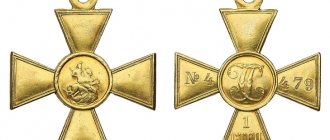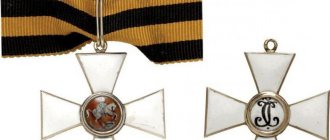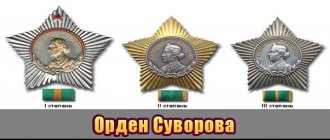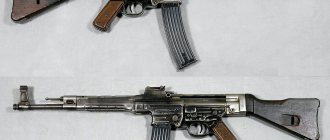Other meanings of this word:
- “those are the true ones...”
- "Here's the true one..."
- “This is what... the life-giving one does!”
- “What is this...? It looks more like the letter "he" ("Ordinary Miracle")
- “What is this...? It looks more like the letter "he" ("Ordinary Miracle")
- “It’s impossible to remember, it’s impossible to forget - this is mine...” (from the Twilight saga)
- "Serial" Christian monument
- “I just... took with me what you gave me on the day of betrayal”
- What constellation is the star Acrux in?
- hangs on the chest of a Christian
- the expression “Borrow under ...” means to borrow without money
- embroidery stitch
- St. George's...
- Order of St. George
- St. George's, body, Southern and even grave
- Load to Golgotha
- To limit the tension force of the mainspring in a watch, a Maltese pin is used...
- drama of the Russian poet A. A. Blok “Rose and ...”
- they kiss him making a vow
- They kiss him, making a vow
- Christmas tree base
- if they put it on something, it means it’s bad
- life-giving sign of the believer
- Life-giving...
- completion of the temple dome
- ambulance sign
- gilded top of the church dome
- oblique... in chess notation means checkmate
- christian prayer gesture
- Christ was crucified on it
- award, order
- confidant...
- adv. crosswise, crosswise, in a cross, crosswise, crosswise or forming a cross. the cross is straight, at a right angle; into the cross obliquely, under the oblique
- body worn on a chain
- What was Christ crucified with?
- illiterate people put it instead of a signature
- Carried by Christ to Golgotha
- The burden of each of us
- the burden of Christ on the road to Calvary
- amulet on a chain for a Christian
- one of the combinations in volleyball
- Christian cult object
- a spacer that prevents the world's jaws from closing around a Christian
- Crucifixion
- the role of A. Yakovlev in the film “A Visit to the Minotaur”
- sacred symbol
- Club suit symbol
- Symbol of Christian cult
- Symbol of Christianity
- Constellation Southern...
- remedy for evil spirits
- put on a lost cause
- Standing on the grave
- Suffering, torment
- something that is not placed on mass graves
- Christians: prayer hand gesture
- Ring exercise
- Figure for crucifixion
- A figure of two lines intersecting at right angles
- Vladimir Gardin's film "... and the Mauser"
- form of the order
- swastika shape
- Christian. symbol, crowning church
- Christian symbol consecrated by the blood of Christ
- Christian symbol
- what Jesus carried to Calvary
- What did Jesus carry to Calvary?
- What's hanging on the priest's chest?
- what does the Polish word “krzyz” mean, from which the kryzhachok dance originated?
- What does the Polish word “krzyz” mean, from which the dance kryzhachok originates?
- That they bet on hopelessness. business?
- that they bet on a lost cause
- What do they bet on a lost cause?
- what is on the top of the church?
- what is installed on the top of the church?
- element in architecture
Si vis pacem, para bellum!
02/13/2014 St. George's Cross
Tweet
The “Cross of St. George” is the most legendary, revered and widespread award of the Russian Empire and the most famous in the military history of Russia.
Initially, this award was called the “Insignia of the Military Order of the Holy Great Martyr and Victorious George” and was established by the Highest Order of Emperor Alexander I of February 13 (23), 1807 as a reward for lower military ranks for “undaunted courage.” The name of the first recipient of this award is Yegor Ivanovich Mitrokhin, non-commissioned officer of the Cavalry Regiment - for the battle at Friedland, in Prussia on December 14, 1809, “for the skillful and brave execution of orders.”
Award rules. Unlike all other soldier’s medals, the Cross of St. George was awarded exclusively for a specific feat, because “this insignia is acquired only on the battlefield, during the siege and defense of fortresses, and on the waters in naval battles.” The list was clearly and down to detail regulated by its Statute.
It is characteristic that not only a soldier could receive an award for the feat indicated there. The future Decembrists Muravyov-Apostol and Yakushkin, who fought at Borodino with the rank of ensign, which did not give the right to an officer's award, received St. George's Crosses No. 16697 and No. 16698. There is a known case of a general being awarded a soldier's award - Count Mikhail Miloradovich in a battle with the French in a soldier's ranks in the battle near Leipzig received the St. George Cross, 4th degree.
Privilege. The lower rank - holder of the St. George Cross in the army was spared from corporal punishment. The soldier or non-commissioned officer awarded it received a salary one third more than usual, for each new cross the salary was increased by another third until the salary doubled. The additional salary remained for life after retirement; widows could receive it within a year after the death of the gentleman.
Degrees. On March 19, 1856, four degrees of awards were introduced, and awards were made sequentially. The badges were worn on a ribbon on the chest and were made of gold (1st and 2nd) and silver (3rd and 4th). The numbering of characters was no longer general, but began anew for each degree. “Either his chest is covered in crosses, or his head is in the bushes” - that’s all about him.
Full Knight of St. George - all four degrees of the cross. It is known that Semyon Mikhailovich Budyonny, being a Full Knight of St. George, received crosses 5 times, moreover, because of his love of fighting. He was deprived of his first award, the St. George Cross of the 4th degree, in court for assault on a senior in rank. I had to receive the award again, this time on the Turkish front, at the end of 1914. He received the St. George Cross, 3rd degree, in January 1916 for participating in the battles near Mendelij. In March 1916 - awarded the cross of the 2nd degree. In July 1916, Budyonny received the St. George Cross, 1st degree, for the fact that five of them brought 7 Turkish soldiers from a sortie.
Women Knights of St. George. There are several known cases of women being awarded the cross. “Cavalry Maiden” Nadezhda Durova, who received the award in 1807, in the lists of cavaliers she is listed under the name of cornet Alexander Alexandrov. For the battle of Dennewitz in 1813, another woman received the St. George Cross - Sophia Dorothea Frederica Kruger, a non-commissioned officer from the Prussian Borstell brigade. Antonina Palshina, who fought in the First World War under the name Anton Palshin, had the St. George Cross of three degrees. Maria Bochkareva, the first female officer in the Russian army, commander of the “women’s battalion of death” had two Georges.
For foreigners.
For non-believers. From the end of August 1844, a special cross was installed to reward military personnel of other religions; it differed from the usual one in that the coat of arms of Russia, a double-headed eagle, was depicted in the center of the medallion. The first full holder of the cross for non-believers was Labazan Ibrahim Khalil-ogly, a police cadet of the 2nd Dagestan Cavalry Irregular Regiment.
St. George's Cross. The award began to be officially called the “St. George Cross” in 1913, when the new statute of the “insignia of the Military Order” was approved, and the numbering of crosses began anew from that time. The new statute also introduced lifelong allowances: for the 4th degree - 36 rubles, for the 3rd degree - 60 rubles, for the 2nd degree - 96 rubles and for the 1st degree - 120 rubles per year, for gentlemen of several degrees an increase or the pension was paid only for the highest degree. A pension of 120 rubles in those days was quite a decent amount; the salary of a skilled worker in 1913 was about 200 rubles a year.
About numbering. The first crosses of 1807 were not numbered. This was corrected in 1809, when it was ordered to compile precise lists of gentlemen, and the crosses were temporarily removed and numbered. Their exact number is known - 9,937.
The numbering of the crosses was renewed several times - by the different design of the numbering font, you can determine which period the award belongs to. When during the First World War the number of awards exceeded a million, the designation 1/M appeared on the reverse, on the upper ray of the cross.
St. George Ribbon. It is traditionally believed that the colors of the ribbon - black and yellow - mean “smoke and flame” and are a sign of a soldier’s personal valor on the battlefield. Another version is that these colors are based on the life of St. George the Victorious and symbolize his death and resurrection: St. George went through death three times and was resurrected twice. There is also a simpler version. The colors of the ribbon when establishing the Order of the Holy Great Martyr and Victorious George in 1769 were established by Catherine II and for the color of the ribbon she took the colors of the imperial standard: black and yellow-gold, excluding white.
On September 10, 1916, according to the Highest approval of the opinion of the Council of Ministers, gold and silver were removed from the St. George Cross. They began to be stamped from White and Yellow metal. These crosses have the letters “BM” and “ZhM” under their serial numbers.
After February 1917. On July 24, 1917, the Provisional Government adopted a resolution according to which officers who distinguished themselves in battle were also awarded the Cross of St. George. To receive an award, a decision of a meeting of lower ranks was required. Also, the award of the Laurel branch was established to the cross. It was made according to the color of the metal of the cross.
During the Civil War 1917-1922. in the White Army, awarding crosses was rare, especially in the initial period - the White Guard considered it immoral to award military awards to Russians for their exploits in the war against the Russians. General Wrangel, in order not to award the Cross of St. George, established a special order of St. Nicholas the Wonderworker, which was equivalent to the St. George's.
The last Knight of St. George awarded on Russian soil in 1920 was 18-year-old sergeant P.V. Zhadan, for saving the headquarters of the 2nd Cavalry Division of General Morozov. Zhadan, at the head of a squadron of 160 sabers, scattered the cavalry column of the red division commander Zhloba.
The last awards took place in 1941 in the ranks of the Russian Corps, a collaborationist formation that fought on the side of Nazi Germany in Yugoslavia with the partisan detachments of the People's Liberation Army of Yugoslavia Josip Broz Tito.
Cross to the Great Patriotic War. The Soldier's Order of Glory of three degrees, established at the height of the Great Patriotic War, became an analogue of the St. George Soldier's Cross in the Soviet Army. The statute of the order resembles the provision of the St. George Soldier's Cross. The Order has the same black and orange ribbon as the soldier's George.
The cap stripes of the crews of the guards warships of the navy are painted in the same colors. The medal “For the victory over Germany in the Great Patriotic War of 1941-1945” was approved on the St. George’s coloring ribbon.
Contrary to popular belief, the Cross of St. George was not “legalized” by the Soviet government or officially allowed to be worn by Red Army soldiers. After the start of the Great Patriotic War, many older people were mobilized, among whom were participants in the First World War who were awarded the Cross of St. George. Such servicemen wore awards “in person”, in which no one interfered with them, and enjoyed legitimate respect in the army.
After the introduction of the Order of Glory into the system of Soviet awards, which was in many ways similar in ideology to the “soldier’s George,” an opinion arose to legitimize the old award. In particular, we know a letter addressed to the Chairman of the Council of People's Commissars and the State Defense Committee I.V. Stalin from a professor at VGIK, a former member of the first Military Revolutionary Committee for Aviation of the Moscow Military District and Knight of St. George N.D. Anoshchenko with a similar proposal.
This movement ultimately resulted in a draft resolution of the Council of People's Commissars:
DRAFT DECREE OF THE USSR Council of People's Commissars
April 24, 1944 In order to create continuity in the fighting traditions of Russian soldiers and pay due respect to the heroes who defeated the German imperialists in the war of 1914-1917, the Council of People's Commissars of the USSR decides: 1. Equate b. cavaliers of St. George, who received the Cross of St. George for military exploits performed in battles against the Germans in the war of 1914-17, to the cavaliers of the Order of Glory with all the ensuing benefits. 2. Allow b. St. George's cavaliers wear a pad with an order ribbon of the established colors on their chest. 3. Persons subject to the effect of this resolution are issued an order book of the Order of Glory marked “b. St. George's Knight", which is formalized by the headquarters of military districts or fronts on the basis of the submission of relevant documents to them (original orders or service records of that time).
But, unfortunately, the project never became a real resolution...
1945. Member of three wars, Guard Private F. G. Vadyukhin. A famous photograph testifying to an unusual rule for the Red Army that appeared during the war - holders of the Cross of St. George were unofficially allowed to wear these awards. In addition to the St. George Cross and the Guards Badge, the photo shows orders and medals of the Soviet Union: the Order of the Red Star, the Order of Glory of the third degree (awarded for assisting 40 wounded and evacuating 25 wounded under enemy fire on December 26-31, 1944 in the area of the village of Muzikas in Latvia) and two medals “For Courage”.
Archive. Data on those awarded the St. George Cross is currently stored in the Russian State Military Historical Archive (RGVIA) in Moscow. The data is incomplete - some of the documents from military units did not have time to get into the archives due to the events of 1917. After the First World War, it was planned to build a temple and memorial dedicated to all the Knights of St. George, but for known reasons the good initiative was never realized.
In 1992, by decree of the Presidium of the Supreme Council of the Russian Federation dated March 2 No. 2424-I “On state awards of the Russian Federation,” the military Order of St. George and the sign “George Cross” were restored. Now 11 people have been awarded it.
Website materials used: https://foto-history.livejournal.com/3509535.html and https://clubs.ya.ru
Related publications:
- Union Jack - UK flag
Posted in Military awards and tagged St. George's Cross
Battle of Cahul: the most massive distribution of a military order
The first award of “George” of the second highest degree took place on July 27, 1770 (old style). Strictly speaking, there were not one, but three awards of the second degree: Lieutenant General P. G. Pemyannikov and N. V. Repnin and Quartermaster General F. V. Bour. All awards were awarded for distinction in the battle with the Turks at Kagul, during during which the 1st Russian army under the command of General-in-Chief Pyotr Rumyantsev inflicted a crushing defeat on the army of the Grand Vizier. The battle became a milestone in the history of military art: for the first time, the main forces of the Russians fought with such a decisive superiority of the enemy (there were 7-10 Turks per Russian) and with such an impressive result. All three awards were accompanied by a resolution: “For providing an example of courage, serving his subordinates in overcoming the work of fearlessness and achieving victory over the enemy on July 21, 1770 near Cahul.”
It is curious that one of the gentlemen was Nikolai Repnin, better known as a diplomat rather than a commander: being the Russian envoy to Poland and seeking to carry out radical pro-Russian reforms, it was he who was responsible for the creation of the Bar Confederation in the Polish-Lithuanian Commonwealth, hostile to Russia, the war with which and its further The defeat led to the first partition of Poland. He also developed the provisions of the Kyuchuk-Kainardzhi Peace following the war with Turkey in 1768-1774. However, as we see, the military field was also not alien to the prince: he participated in all the major battles of 1770, in which he invariably showed himself to be a brave man and an excellent commander.
Battle of Kagul. Source: wikimedia.org
The Battle of Kagul (following Ryaba Mogila and Larga) was the third major victory of Russian weapons during this campaign; it crowns the pre-Suvorov stage of development of military art in Russia. However, these victories led to another interesting consequence: July 27, 1770 became the day of one of the most massive awards of the Order of St. George. 22 awards of all levels were presented. Moreover, additional awards took place in August 1770. So the Empress decided to reward the troops who had won the most resounding victories of Russian weapons since the time of Peter the Great.
Rumyantsev-Zadunaisky - count, cavalier, winner
The second in order and the first military Order of St. George, 1st degree, was awarded on July 27, 1770 to General-Chief Rumyantsev, who received the honorary prefix Zadunaysky for his actions. The awarding of the field marshal (another encouragement for Cahul) with the highest military award was completely deserved: after Rumyantsev was appointed commander of the Danube, things in the army went smoothly. The experience of the Seven Years' War, during which the commander repeatedly distinguished himself with his management and eye, as well as natural talents and a subtle understanding of the fundamentals of military art, allowed him to achieve such impressive results. The victory at Kagul, won with little bloodshed thanks to Rumyantsev’s determination in the attack and the excellent training of the combat troops, forced Turkey to ask for peace (however, it never took place - the war resumed in 1773) and deprived the Polish Confederates of hope for the defeat of the Russians and the help of the Sultan.
Rumyantsev-Zadunaisky. Star of the order under "Andrey". (pinterest.ru)
Russian-Polish War
The first award of the order of the fourth degree took place in 1770. For successful actions against the Polish confederates (the so-called war with the Bar Confederation for the establishment of a loyal government of Stanislaw Poniatowski in Poland). At the very beginning of the year, in a battle near the town of Dobre, Second Major (the junior major rank following the captain/captain) of the Kargopol Carabineer Regiment, Reinhold von Patkul, distinguished himself. The officer was awarded the "George" IV degree for "excellent courage against the enemy" with another promotion. The fate of the daring cavalryman was happy - after a year and a half he was promoted to lieutenant colonel, fought under the command of Suvorov at Stavuchany, and in 1780 rose to the rank of major general. It is curious that one of the four full holders of the order, the hero of the Patriotic War, Mikhail Barclay de Tolly, began his officer service as an adjutant under Patkul, and Patkul’s son fought under the command of Barclay in the Battle of Smolensk, for heroism in which he was awarded, like his father, the order St. George IV degree.
The Kargopol residents generally distinguished themselves in this war: the regiment commander was awarded the “George” of the 3rd degree for No. 2 with the wording “for the defeat of the enemy, consisting of about 2,500 people, and the recapture of 3 guns and the entire convoy with three squadrons and 40 Cossacks. In 770, January 12th, for the defeat of an outrageous party in Poland near Orekhovo and the recapture of 15 cannons.” In addition, Colonel Drewits took part in the Battle of Dobro (so disliked by Suvorov for his passion for cruelty and robberies of the civilian population), who received the “George” of the 3rd degree for distinction in battle a year earlier than Alexander Vasilyevich himself. The regiment received praise from Suvorov for the speed and impetus with which the Kargopol cavalrymen acted against the Confederates.
Catherine II. The star of the order is on the mantle on the right. (pinterest.ru)
Soldier General
In the photo: Hero of the Soviet Union Maxim Evseevich Kozyr (Photo: ru.wikipedia.org)
The peasant's son, Maxim Evseevich KOZYR (1890−1945), was drafted into the army in December 1911. Fought in the First World War. He was wounded several times. “During that war, in exchange for four soldiers’ St. George’s, they were given a golden cross with a bow and thereby promoted to lieutenant ensign,” the hero wrote in the questionnaire.
He took the side of the Bolsheviks in December 1917. During the Civil War he fought in Ukraine; participated in battles not only with the whites, but also with the Germans, English and French invaders, the Haidamaks and the troops of the Ukrainian Rada. Awarded the Order of the Red Banner. He graduated from command courses, rose to the rank of colonel, and became deputy division commander. The writer Konstantin Simonov, who met Kozyr at the front, remembered his words: “I have two passions in life - war and agriculture... After the war I want to go into agriculture.”











